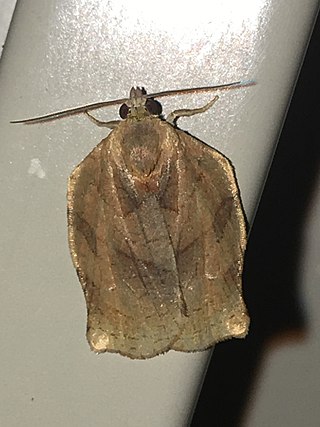
The mottled umber is a moth of the family Geometridae. It is common throughout much of the Palearctic region. The species was first described by Carl Alexander Clerck in 1759.

The University of Delaware Botanic Gardens are botanical gardens and an arboretum located on the campus of the University of Delaware, in Newark, Delaware, United States. The gardens are open to the public without charge.
This article gives an overview of the woodland and scrub communities in the British National Vegetation Classification system.

Sthenopis is a genus of moths of the family Hepialidae. There are eight described species found in North America and China.

The grey dagger is a moth of the family Noctuidae.
NVC community W2 is one of the woodland communities in the British National Vegetation Classification system. It is one of seven woodland communities in the NVC classed as "wet woodlands".

Sterrhopterix fusca is a moth of the Psychidae family. It is found from England through central Europe, east to Russia, north to Fennoscandia, the Baltic States and Karelia. The southern limit of its range ranges from northern Italy to Romania.

Lithophane socia, the pale pinion, is a moth of the family Noctuidae. The species was first described by Johann Siegfried Hufnagel in 1766. It is found throughout western Europe from Spain to central Scandinavia then east across the Palearctic to Siberia, the Russian Far East and Japan.

Trichiura crataegi, the pale eggar or pale oak eggar, is a moth of the family Lasiocampidae. It was first described by Carl Linnaeus in his 1758 10th edition of Systema Naturae. It is found in all of Europe, east to Anatolia and east across the Palearctic to Amur.

Ectoedemia occultella, the small birch leafminer, is a moth of the family Nepticulidae. It has a Holarctic distribution. It is found in most of Europe, east through Russia to Japan. It is also present in North America. Mines very similar to that of Ectoedemia occultella have been found on Rosaceae species in Nepal and Japan and these may belong to this species.

Chloroclysta miata, the autumn green carpet, is a moth of the family Geometridae. The species was first described by Carl Linnaeus in his 1758 10th edition of Systema Naturae. It is found from most of Europe to the Alatau in Central Asia.

Salix arbusculoides is a species of flowering plant in the willow family known by the common name little tree willow. It is native to northern North America, where its distribution extends across Alaska and most of Canada.
Udea inquinatalis is a species of moth in the family Crambidae. The species was first described by Friederike Lienig and Philipp Christoph Zeller in 1846. It is found in most of Europe and North America.

Archips purpuranus, the omnivorous leafroller moth, is a species of moth of the family Tortricidae. It is found in most of eastern North America.












